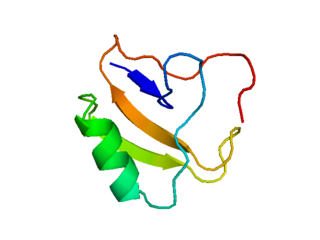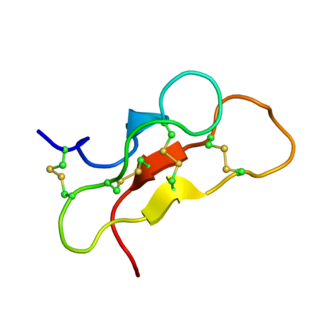Poneratoxin is a paralyzing neurotoxic peptide made by the bullet ant Paraponera clavata. It prevents inactivation of voltage gated sodium channels and therefore blocks the synaptic transmission in the central nervous system. Specifically, poneratoxin acts on voltage gated sodium channels in skeletal muscle fibers, causing paralysis, and nociceptive fibers, causing pain. It is rated as a 4 plus on the Schmidt sting pain index, the highest possible rating with that system, and its effects can cause waves of pain up to twelve hours after a single sting. Schmidt describes it as "pure, intense, brilliant pain...like walking over flaming charcoal with a three-inch nail embedded in your heel." It is additionally being studied for its uses in biological insecticides.
Tityustoxin is a toxin found in the venom of scorpions from the subfamily Tityinae. By binding to voltage-dependent sodium ion channels and potassium channels, they cause sialorrhea, lacrimation and rhinorrhea.

Scorpion toxins are proteins found in the venom of scorpions. Their toxic effect may be mammal- or insect-specific and acts by binding with varying degrees of specificity to members of the Voltage-gated ion channel superfamily; specifically, voltage-gated sodium channels, voltage-gated potassium channels, and Transient Receptor Potential (TRP) channels. The result of this action is to activate or inhibit the action of these channels in the nervous and cardiac organ systems. For instance, α-scorpion toxins MeuNaTxα-12 and MeuNaTxα-13 from Mesobuthus eupeus are neurotoxins that target voltage-gated Na+ channels (Navs), inhibiting fast inactivation. In vivo assays of MeuNaTxα-12 and MeuNaTxα-13 effects on mammalian and insect Navs show differential potency. These recombinants exhibit their preferential affinity for mammalian and insect Na+ channels at the α-like toxins' active site, site 3, in order to inactivate the cell membrane depolarization faster[6]. The varying sensitivity of different Navs to MeuNaTxα-12 and MeuNaTxα-13 may be dependent on the substitution of a conserved Valine residue for a Phenylalanine residue at position 1630 of the LD4:S3-S4 subunit or due to various changes in residues in the LD4:S5-S6 subunit of the Navs. Ultimately, these actions can serve the purpose of warding off predators by causing pain or to subdue predators.
Birtoxin is a neurotoxin from the venom of the South African Spitting scorpion. By changing sodium channel activation, the toxin promotes spontaneous and repetitive firing much like pyrethroid insecticides do
Bestoxin is a neurotoxin from the venom of the South African spitting scorpion Parabuthus transvaalicus. Most likely, it targets sodium channel function, thus promoting spontaneous and repetitive neuronal firing. Following injection into mice, it causes non-lethal writhing behaviour.
BmKAEP is a neurotoxin from the venom of the Manchurian scorpion (Mesobuthus martensii). It is a β-toxin, which shift the activation voltage of sodium channels towards more negative potentials.
Jingzhaotoxin proteins are part of a venom secreted by Chilobrachys jingzhao, the Chinese tarantula. and act as neurotoxins. There are several subtypes of jingzhaotoxin, which differ in terms of channel selectivity and modification characteristics. All subspecies act as gating modifiers of sodium channels and/or, to a lesser extent, potassium channels.
Ikitoxin is a neurotoxin from the venom of the South African Spitting scorpion that targets voltage-sensitive sodium channels. It causes unprovoked jumps in mice following intracerebroventricular injections.

delta-Palutoxins (δ-palutoxins) consist of a homologous group of four insect-specific toxins from the venom of the spider Pireneitega luctuosa. They show a high toxicity against Spodoptera litura larvae by inhibiting sodium channels, leading to strong paralytic activity and eventually to the death of the insect.
Halcurin is a polypeptide neurotoxin from the sea anemone Halcurias sp. Based on sequence homology to type 1 and type 2 sea anemone toxins it is thought to delay channel inactivation by binding to the extracellular site 3 on the voltage gated sodium channels in a membrane potential-dependent manner.
BotIT2 is a neurotoxin from the scorpion Buthus occitanus tunetanus, which modifies activation and slows down the deactivation of voltage gated sodium channels.

Toxin Cll1 is a toxin from the venom of the Mexican scorpion Centruroides limpidus limpidus, which changes the activation threshold of sodium channels by binding to neurotoxin binding site 4, resulting in increased excitability.
BotIT6 is a toxin that binds to insect voltage gated sodium channels. It decreases the amplitude of the action potential, leading to paralysis.
Centruroides suffusus suffusus toxin II (CssII) is a scorpion β-toxin from the venom of the scorpion Centruroides suffusus suffusus. CssII primarily affects voltage-gated sodium channels by causing a hyperpolarizing shift of voltage dependence, a reduction in peak transient current, and the occurrence of resurgent currents.

Noxiustoxin (NTX) is a toxin from the venom of the Mexican scorpion Centruroides noxius Hoffmann which block voltage-dependent potassium channels and calcium-activated potassium channels.
AaTX1 is a scorpion toxin of the α-KTx15 subfamily originally found in the venom of Androctonus australis. The toxin acts as a specific blocker on Kv4.3 voltage-gated potassium channel, thereby abolishing the A-type potassium currents.
Beta-mammal toxin Cn2, also known as Cn2 toxin, is a single chain β-scorpion neurotoxic peptide and the primary toxin in the venom of the Centruroides noxius Hoffmann scorpion. The toxin specifically targets mammalian Nav1.6 voltage-gated sodium channels (VGSC).
Beta-toxin Cll2, shortened to Cll2, is a toxin in the venom of the Mexican Scorpion species Centruroides limpidus limpidus. The toxin belongs to the β-class family of sodium channel-inhibiting scorpion toxins. It affects voltage-dependent activation, conductance and resurgent currents of voltage gated sodium channels by binding to site 4.
LqhIT2 is a long-chain scorpion depressant β-toxin derived from Leiurus quinquestriatus hebraeus. It targets insect voltage-gated sodium channels (Navs) and shifts the voltage dependence of channel activation to a more negative membrane potential.
N58A is a peptide depressant β-neurotoxin found in the venom of East Asian scorpions. The toxin affects voltage-gated sodium channels, specifically Nav1.8 & Nav1.9 channels.



